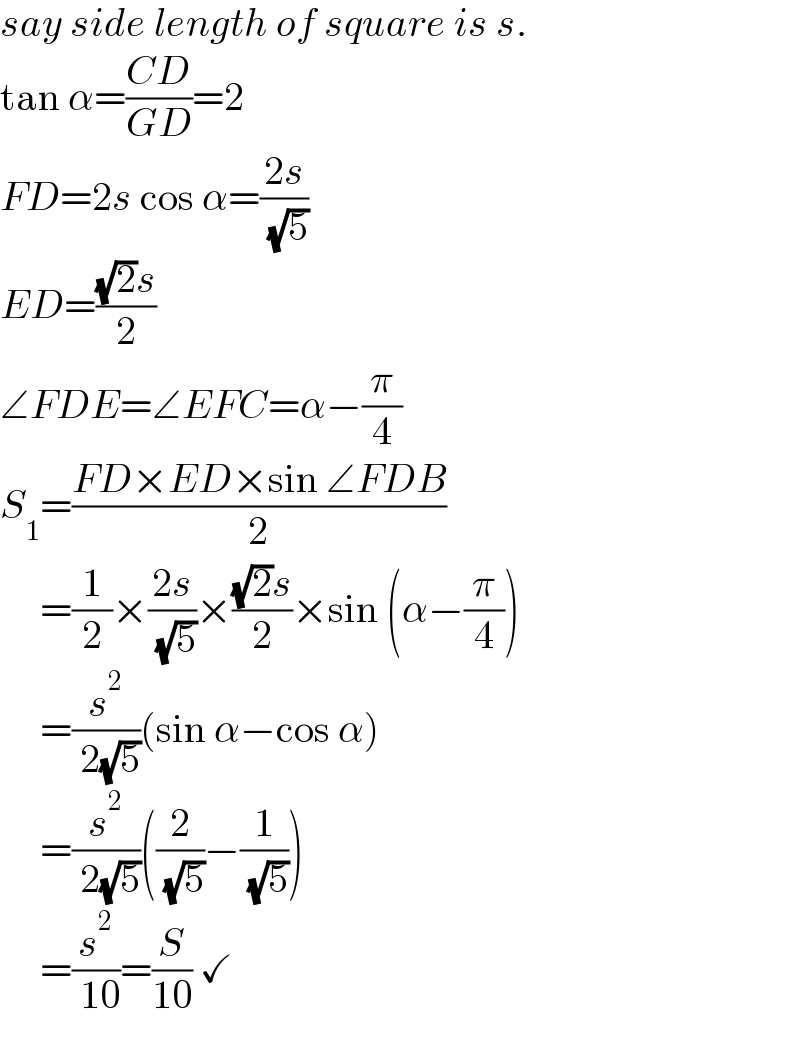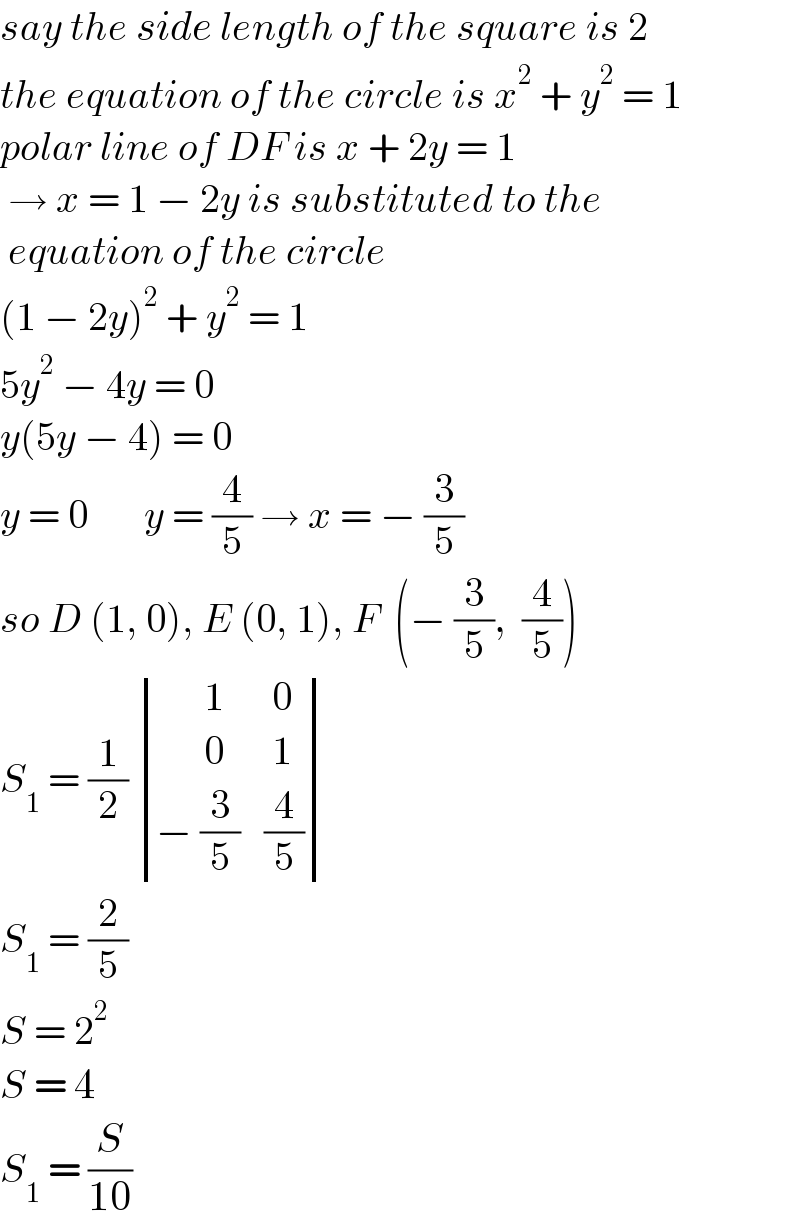Question Number 177910 by HeferH last updated on 11/Oct/22

Answered by mr W last updated on 11/Oct/22

Commented by mr W last updated on 11/Oct/22

$${say}\:{side}\:{length}\:{of}\:{square}\:{is}\:{s}. \\ $$$$\mathrm{tan}\:\alpha=\frac{{CD}}{{GD}}=\mathrm{2} \\ $$$${FD}=\mathrm{2}{s}\:\mathrm{cos}\:\alpha=\frac{\mathrm{2}{s}}{\:\sqrt{\mathrm{5}}} \\ $$$${ED}=\frac{\sqrt{\mathrm{2}}{s}}{\mathrm{2}} \\ $$$$\angle{FDE}=\angle{EFC}=\alpha−\frac{\pi}{\mathrm{4}} \\ $$$${S}_{\mathrm{1}} =\frac{{FD}×{ED}×\mathrm{sin}\:\angle{FDB}}{\mathrm{2}} \\ $$$$\:\:\:\:\:=\frac{\mathrm{1}}{\mathrm{2}}×\frac{\mathrm{2}{s}}{\:\sqrt{\mathrm{5}}}×\frac{\sqrt{\mathrm{2}}{s}}{\mathrm{2}}×\mathrm{sin}\:\left(\alpha−\frac{\pi}{\mathrm{4}}\right) \\ $$$$\:\:\:\:\:=\frac{{s}^{\mathrm{2}} }{\:\mathrm{2}\sqrt{\mathrm{5}}}\left(\mathrm{sin}\:\alpha−\mathrm{cos}\:\alpha\right) \\ $$$$\:\:\:\:\:=\frac{{s}^{\mathrm{2}} }{\:\mathrm{2}\sqrt{\mathrm{5}}}\left(\frac{\mathrm{2}}{\:\sqrt{\mathrm{5}}}−\frac{\mathrm{1}}{\:\sqrt{\mathrm{5}}}\right) \\ $$$$\:\:\:\:\:=\frac{{s}^{\mathrm{2}} }{\:\mathrm{10}}=\frac{{S}}{\mathrm{10}}\:\checkmark \\ $$
Commented by Tawa11 last updated on 11/Oct/22

$$\mathrm{Great}\:\mathrm{sir} \\ $$
Answered by kapoorshah last updated on 11/Oct/22

Commented by kapoorshah last updated on 11/Oct/22

$${say}\:{the}\:{side}\:{length}\:{of}\:{the}\:{square}\:{is}\:\mathrm{2} \\ $$$${the}\:{equation}\:{of}\:{the}\:{circle}\:{is}\:{x}^{\mathrm{2}} \:+\:{y}^{\mathrm{2}} \:=\:\mathrm{1} \\ $$$${polar}\:{line}\:{of}\:{DF}\:{is}\:{x}\:+\:\mathrm{2}{y}\:=\:\mathrm{1} \\ $$$$\:\rightarrow\:{x}\:=\:\mathrm{1}\:−\:\mathrm{2}{y}\:{is}\:{substituted}\:{to}\:{the} \\ $$$$\:{equation}\:{of}\:{the}\:{circle} \\ $$$$\left(\mathrm{1}\:−\:\mathrm{2}{y}\right)^{\mathrm{2}} \:+\:{y}^{\mathrm{2}} \:=\:\mathrm{1} \\ $$$$\mathrm{5}{y}^{\mathrm{2}} \:−\:\mathrm{4}{y}\:=\:\mathrm{0} \\ $$$${y}\left(\mathrm{5}{y}\:−\:\mathrm{4}\right)\:=\:\mathrm{0} \\ $$$${y}\:=\:\mathrm{0}\:\:\:\:\:\:\:{y}\:=\:\frac{\mathrm{4}}{\mathrm{5}}\:\rightarrow\:{x}\:=\:−\:\frac{\mathrm{3}}{\mathrm{5}} \\ $$$${so}\:{D}\:\left(\mathrm{1},\:\mathrm{0}\right),\:{E}\:\left(\mathrm{0},\:\mathrm{1}\right),\:{F}\:\:\left(−\:\frac{\mathrm{3}}{\mathrm{5}},\:\:\frac{\mathrm{4}}{\mathrm{5}}\right) \\ $$$${S}_{\mathrm{1}} \:=\:\frac{\mathrm{1}}{\mathrm{2}}\:\begin{vmatrix}{\:\:\:\:\:\:\mathrm{1}}&{\:\mathrm{0}}\\{\:\:\:\:\:\:\mathrm{0}}&{\:\mathrm{1}}\\{−\:\frac{\mathrm{3}}{\mathrm{5}}}&{\frac{\mathrm{4}}{\mathrm{5}}}\end{vmatrix} \\ $$$${S}_{\mathrm{1}} \:=\:\frac{\mathrm{2}}{\mathrm{5}} \\ $$$${S}\:=\:\mathrm{2}^{\mathrm{2}} \\ $$$${S}\:=\:\mathrm{4} \\ $$$${S}_{\mathrm{1}} \:=\:\frac{{S}}{\mathrm{10}} \\ $$
Commented by Tawa11 last updated on 11/Oct/22

$$\mathrm{Great}\:\mathrm{sir} \\ $$
